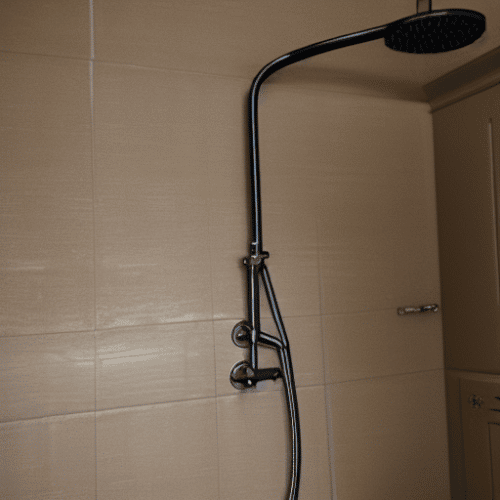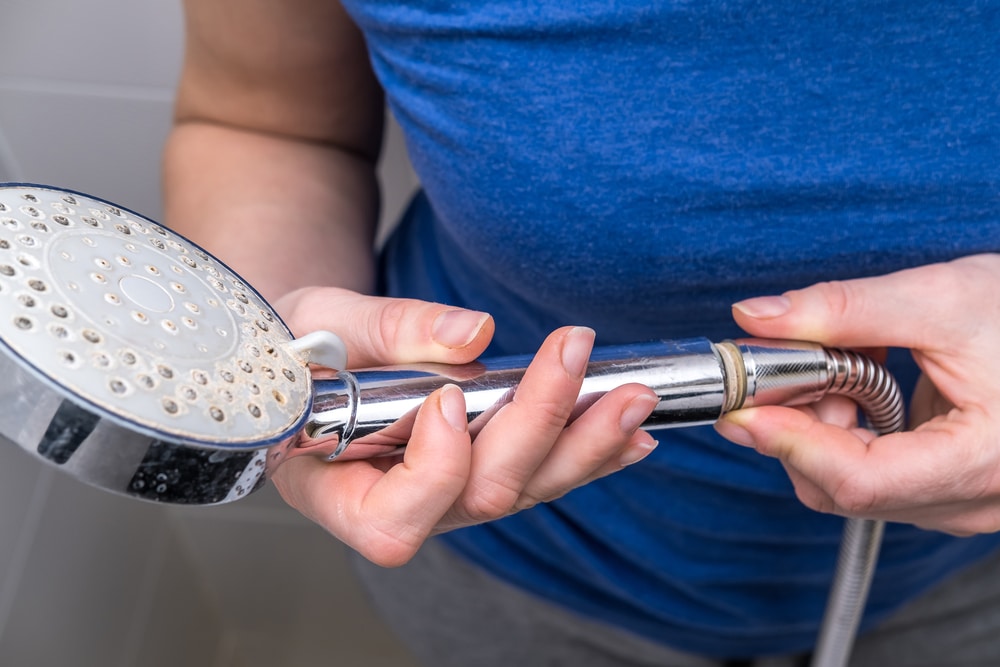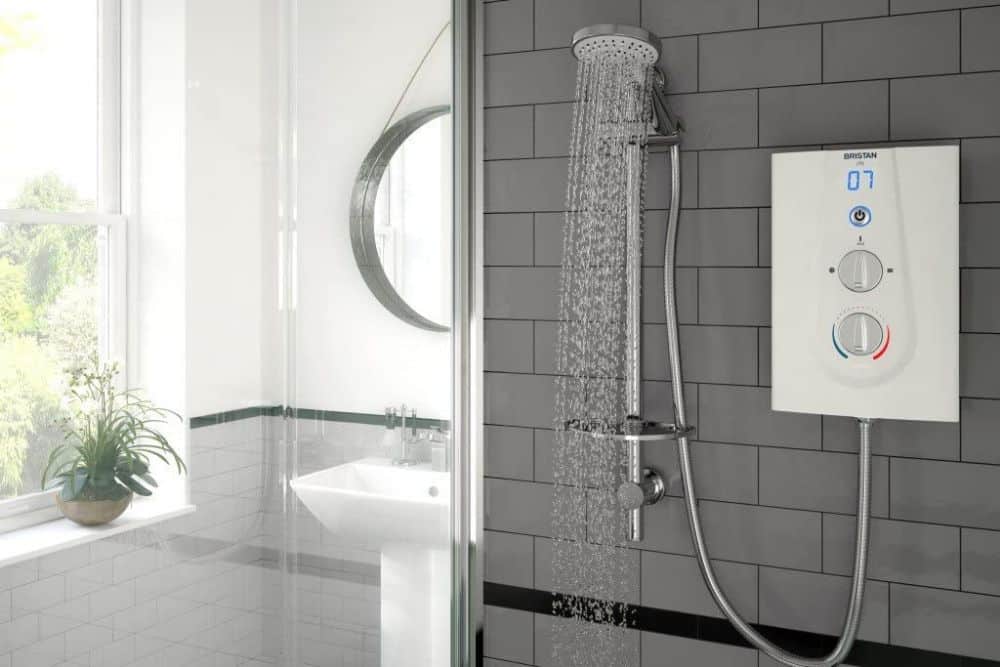Last Updated on
Your bathroom should be the most hygienic area in your home, but that won’t be the case with mould and limescale build-up.
In this post, we’ll share some practical methods to keep your shower head and bathroom fixtures free of calcium carbonate and spotless. Eradicate any unwanted build-ups by following the tips and tricks in today’s article on how to descale an electric shower!
Descaling Your Shower Head
It’s not as difficult to descale your shower as you might have thought. Follow these steps below to remove tough limescale from your shower. You can either develop your own mixture that can power through and works well for all models or buy a store-bought limescale remover loaded with chemicals.
What you’ll need:
- Bicarbonate of soda, lemon juice or vinegar
- Used toothbrush
- Soft, clean towel
- Bucket (you can also use a sink)
Step 1: Remove the Shower Head
The first step is to remove the showerhead. It’s best to do this when the electric shower head is dry (so not immediately after a shower), but you can also use a towel to help you get some friction and remove it from the wall.
Step 2: Create the Solution
Next, you want to add 3 tbsp white vinegar and enough water to immerse the showerhead into a bucket or your bathroom sink. Then, soak the showerhead in the vinegar solution for up to an hour or overnight, depending on the number of limescale deposits and when you next need to use the shower. The acid in the vinegar will work to dissolve any limescale build-ups.
Step 3: Scrub the Shower Head
Once the chosen time is up, leave the vinegar solution on the showerhead and, using a toothbrush, scrub the exterior to remove any limescale deposits. You should see these fall off the showerhead if any remain on the exterior after the soaking step.
Most of the limescale will build upon the nozzles, so ensure that you focus on this area.
Step 4: Rinse the Shower Head
Once you’ve scrubbed the showerhead, you can rinse it with cold water to remove any residue and solution.
Step 5: Dry the Shower Head
Finally, it’s time to get your showerhead ready to attach back to the bath. But before you do that, you’ll need to dry it using a soft, clean cloth or towel. Visually inspect that you’ve removed any residue deposits from the showerhead. Finally, switch on the shower and spray some cold water out of the head at the strongest setting to remove any solution build-up from within the nozzles.
Alternative Limescale-Remover Solutions
For step 2 above, you’ll need to use a limescale remover. There is also the option of bicarbonate of soda, lemon juice or vinegar unless you choose to buy a store-bought descaler.
Bicarbonate of Soda
For this mixture, you combine two parts of bicarbonate of soda with one part of white vinegar to create a paste. Then, apply this mixture to limescale build-up and sit for 10 minutes before scrubbing off with an abrasive sponge. The reaction with the acid will help dislodge any deposits, thoroughly descaling your shower in the process.
Lemon
Alternatively, lemon juice or fresh lemon makes another great alternative to just vinegar because the acid naturally breaks down limescale, resulting in a cleaner bathroom.
Cut a fresh lemon in half (don’t store it in the fridge because this can dehydrate the lemon). Rub the fresh side of the lemon directly onto the showerhead. Leave this to sit for an hour. After this period, scrub the showerhead with an old toothbrush to unclog any limescale build-up.
Lemon juice works best as frequent descaling sessions as opposed to the initial clean because it may not remove stubborn limescale that’s been stuck on your shower appliance for months.
Why You Should Clean Your Shower Head
So what’s the deal with cleaning your shower head anyway, and why’s it necessary? Well, anything that cleans also needs cleaning to remain hygienic and in good working order. This also applies to showerheads that aren’t self-cleaning. Used daily, watercourses through the head can cause calcium and limescale build-up on the surface, especially if you live in a hard water area. Plus, as shower heads are hot and damp, they create the perfect surface for mould growth. Scientists have discovered that showerheads can cause fest mycobacterium—a form of mould that can cause lung disease.
What Exactly Is Limescale?
We’ve talked about ways to remove limescale, but what exactly is limescale and what’s all the fuss around it? Limescale has a white, chalky (sometimes even pink or brown) appearance that’s a hard substance found in places with hard water, such as bathroom tiles, sinks, kettles and appliances like kettles and washing machines.
Areas with hard water are at particular risk of limescale, as this means that your water contains high concentrations of the minerals that cause it.
Nobody likes the look of limescale: it makes your home look neglected and dirty. Plus, limescale build-up can be difficult to remove since it can have a thick, crusty texture.
Problems With Limescale
We mentioned that limescale could look nasty in your home, but what problems does limescale bring, and why is it so important to keep on top of it?
Increased Energy Costs
Nobody wants to intentionally increase their energy bills, which is why we’re all looking for ways to lower our monthly costs. But when your heating system is clogged with limescale, it becomes harder for the system to generate heat, meaning that your heating appliances have to work harder to reach the desired temperature. Just 1mm of limescale in your hot water system can increase your costs by 7%, which could be an extra £200 annually.
Damage Your Shower Head
Limescale can also reduce the longevity of your shower head, meaning that you’re more likely to have to rush out and purchase a new unit. This is because limescale build-up can clog a water flow, making your shower head work harder to push out the water, meaning that you run a longer shower. Not only is this likely to make you late for work in the morning, but you’ll end up spending more money on repairs and replacing the showerhead when you could’ve just learned how to remove limescale in the first place.
Extra Cleaning Duty
Who wants to spend more time cleaning their home? Not us! It requires effort and time to remove limescale, so you’ll need to indulge in more frequent (and longer) cleaning sessions to remove its build-up. Mixing cleaning solutions take time and money and can be a nuisance for those already stuck for spare time.
Signs Your Bathroom Shower Head Needs Cleaning
Not sure if your shower head is ready for a descaler? Below are some common signs to look out for that indicate it’s time to keep on top of cleaning your bathroom.
- Some nozzles in the shower head have become blocked and aren’t spraying any water
- Water is spraying in various directions, making it hard to have a shower
- Even if the hot water is turned on, the water pressure is gentle
- You notice a pink or orange goop around the nozzles, or there’s a white crust formed on the shower head’s surface.
How Often Should You Clean Your Shower Head?

Showers can harbour mould and all sorts of nastiness, so it’s important that you regularly disinfect them. We suggest once every three months or more often if you have a large household where the shower is used several times each day.
You should also keep in mind if you have hard water as this will require more frequent cleaning. To keep on top of disinfecting your bathroom, we suggest marking your cleaning sessions in a diary and even setting a reminder when the next disinfecting session is due so you don’t forget.
It’s best to follow a cleaning method frequently rather than waiting until your head is affected by grime and mould.
Is It Time to Replace Your Shower Head?
Limescale build-up can be a pain, but a vigorous cleaning process allows you to keep your shower head at its best performance. However, check some of the signs below to see if it’s time to buy a completely new showerhead:
- Constant low pressure, even after leaving no limescale or mould behind.
- Continuous leaks, even after switching off the shower, and you haven’t used it that day. The last thing you want is to fill your time with plumbing chores all the time.
- A heavy build-up of mould
No More Blockage
Prevention is better than cure, so get into the habit of regularly cleaning your shower head—especially if you have hard water. A great tip is to purchase a daily cleaning spray specially designed for bathrooms, as it can prevent mineral build-up and keep your showers feel from grime.
Don’t use bleach cleaning sprays or pure bleach on your shower head, as this can damage the filter screen, and it may also pour onto your skin if you don’t wash it off thoroughly.
Knowing how to descale an electric shower is important in maintaining its performance and ensuring no limescale is left behind.
Amy is a U.K.-based writer and editor with a penchant for helping consumers find the best home products for their needs, as well as providing easily digestible guides for living better at home. Her dedication to her work means she can usually be found elbow-deep in research or hunting down samples of the latest and greatest on behalf of her readers.
An avid DIYer herself, Amy’s passion lies in teaching others how they too can achieve their dream homes by tackling some of those pesky projects themselves! Whether it’s building furniture from scratch or turning an old dresser into a coffee table, Amy is always happy to share what she knows about making your house feel like home without spending a fortune.



